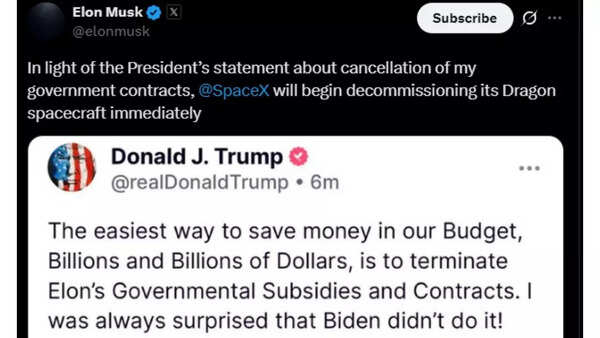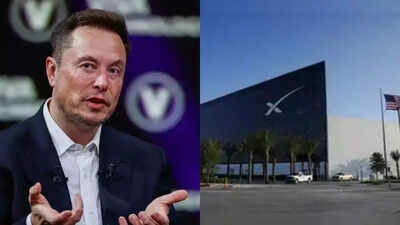Elon Musk’s feud with Trump puts $22B SpaceX contracts at risk; what it means for US space future | – The Times of India

Elon Musk’s escalating feud with President Donald Trump has put SpaceX’s massive $22 billion in government contracts on the line, raising concerns about the future of America’s space program. SpaceX, a key player in NASA and Pentagon missions, faces potential funding cuts amid political tensions, threatening crucial projects like lunar exploration and national security launches. This conflict highlights the risks of heavy reliance on a single private company for space access. After Elon Musk tweeted regarding the decommissioning of SpaceX within a few hours, Musk re-tweeted by saying “Ok. Good Advice…”. However, according to Bloomberg, it remains unclear. But if the dispute unfolds, the US space industry may face delays, higher costs, and increased geopolitical vulnerability, putting America’s leadership in space at stake.
Elon Musk’s Crew Dragon retirement talk highlights US dependence on SpaceX
Elon Musk alluded on X (formerly Twitter) to the possibility that SpaceX would retire its Crew Dragon fleet. Although he subsequently appeared to walk back the announcement, the fact that the idea had been suggested at all highlighted the degree to which the US depends on a single private firm.If SpaceX discontinue its astronaut launches:
- Existing ISS crew might be stuck, although SpaceX will probably bring the Crew Dragon capsule back to the ISS already docked.
- No near-term replacement is on the horizon. Boeing’s Starliner won’t be ready until at least 2026. Russian Soyuz might be an option once more but buying seats from Russia is costly and politically charged.
- The ISS would lose its operational rhythm, potentially dwindling to a ghost crew of three astronauts riding on one Soyuz.
- Essentially, America would be in the same position it was in 2011 relying on another country for access to space.

Source: X

Source: X
How Elon Musk’s SpaceX disrupted Space launch with Falcon 9
SpaceX finally sent up its first successful rocket, Falcon 1, in 2008, after three failures. The breakthrough came in 2010 with the introduction of the Falcon 9, a two-stage, partially reusable rocket that could transport heavy payloads to orbit. The vehicle would come to serve as the workhorse of the international launch industry. NASA invested heavily in Falcon 9’s development, both financially and symbolically. With NASA money and cooperation, SpaceX demonstrated that it could safely transport cargo to the ISS. This stamp of approval drew private satellite users, foreign nations, and eventually even the US military.The conjunction of:
- Low cost per launch,
- Rapid reusability, and
- A demonstrated history of mission success transformed SpaceX into a disruptor, transforming the economics of spaceflight.
SpaceX restores American Human Spaceflight after Shuttle retirement
After the Space Shuttle’s retirement in 2011, NASA was forced to use Russian Soyuz vehicles to transport astronauts to the ISS; a reliance that had geopolitical and budgetary risks. NASA contracted with both Boeing and SpaceX in 2014 to create crewed vehicles under the Commercial Crew Program. SpaceX came first.In May 2020, amid the COVID-19 pandemic, the Crew Dragon Demo-2 mission carried NASA astronauts Doug Hurley and Bob Behnken to the ISS, marking the first human launch from US soil in nearly a decade. President Donald Trump called the mission “a gift” to the nation and praised the cost-efficiency and innovation of the public-private partnership.Crew Dragon’s achievement was not only a national record, but it was also an international show of SpaceX’s ability to send humans to space safely, something only three countries had been able to do before.
SpaceX’s historic 2020 launch: A new era in US human spaceflight
Since the Crew Dragon achievement, SpaceX has increased its activities at a blistering pace:
- Lunar missions: SpaceX received a $2.9 billion contract to create the Human Landing System (HLS)—a version of Starship to carry astronauts to the Moon—under the Artemis program.
- National security: SpaceX puts spy satellites, missile warning satellites, and classified Department of Defense payloads into orbit.
- Commercial leadership: It puts most of the world’s private satellites, such as megaconstellations like Starlink, into orbit.
In practice, SpaceX is not merely a contractor but the linchpin of America’s space architecture.
Why NASA’s backup launch options still lag behind SpaceX’s reliability
The US government and NASA have attempted to diversify their launch suppliers, but substitutes fall far behind:
- Boeing Starliner: Plagued by software issues and hardware flaws. Following a nine-month hiatus in bringing back astronauts, public trust has diminished.
- Northrop Grumman Cygnus: Offers only cargo, and its most recent spacecraft was compromised in transit.
- Sierra Space Dream Chaser: Still has yet to fly; its first flight is scheduled for late 2025 on a tentative basis.
- Blue Origin New Glenn: Just completed its first test flight. Full certification and routine launches are years off.
Although some of these vehicles will develop into capable platforms, none yet equals SpaceX’s launch pace, reliability, or human-rated certification.
SpaceX’s growing role in government space missions
According to the reports, beyond just transporting astronauts, SpaceX has taken on numerous science missions for NASA and deployed military equipment for the Pentagon. Last year, it secured a NASA contract to safely deorbit the International Space Station once its mission concludes. SpaceX’s Starship rocket has been selected by NASA to transport astronauts from lunar orbit to the moon’s surface for upcoming Artemis missions. However, its ninth test flight last week ended in failure after the rocket lost control and crashed over Texas.
$22 billion government contracts on the line
SpaceX currently holds approximately $22 billion in government contracts, covering critical projects for NASA and the Department of Defense according to ET reports. US President Trump claimed that cutting federal support for Elon Musk’s ventures could save “billions and billions of dollars.” The dispute began when Trump criticized Musk’s spending priorities and withdrew support for billionaire private astronaut Jared Isaacman, labeling him “totally Democrat.” Recent reports indicate Trump may nominate retired Air Force Lieutenant General Steven Kwast, a strong advocate for space defense, to head NASA. This move could shift NASA’s focus from Musk’s innovation-driven approach toward a greater emphasis on national security.Also Read | Every 26 seconds, Earth’s ‘mysterious heartbeat’ repeats; scientists still don’t know why
















